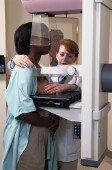Breast Calcification May ID Worsening Kidney Disease
Breast arterial calcification may have a role as a specific marker of medial vascular calcification in chronic kidney disease (CKD), and it is significantly increased in end-stage kidney disease (ESKD), according to a study published online Jan. 21 in the Clinical Journal of the American Society of Nephrology.

MONDAY, Jan. 24 (HealthDay News) -- Breast arterial calcification may have a role as a specific marker of medial vascular calcification in chronic kidney disease (CKD), and it is significantly increased in end-stage kidney disease (ESKD), according to a study published online Jan. 21 in the Clinical Journal of the American Society of Nephrology.
Valerie Duhn, M.D., from the Emory University School of Medicine in Atlanta, and colleagues carried out histological examinations of breast tissue and used mammograms and radiographs of extremities in patients with CKD or ESKD to identify arterial calcification.
The investigators identified medial calcification in all 16 specimens from patients with CKD or ESKD. Breast arterial calcification was seen in 63 percent of mammograms from 71 women with ESKD, compared to 17 percent in women without renal insufficiency. The calcification was present in 36 percent of mammograms from the same patients carried out an average of 5.5 years before the onset of ESKD, but in only 14 percent of patients with stage 3 CKD. A comparison of mammograms and extremity radiographs showed that breast arterial calcification was present in more than 90 percent of patients with peripheral arterial calcification.
"This is the first detailed examination of breast arterial calcification and its prevalence in CKD and is the first study to provide histologic correlation," the authors write.
AbstractFull Text (subscription or payment may be required)
Related Content
Are you planning to start a family?
Integrating HCV screening with breast cancer programs enhances care
June 25th 2024A recent study from France demonstrates that incorporating hepatitis C virus screening into breast cancer programs significantly improves patient engagement and access to effective antiviral treatments among older women.
Read More
